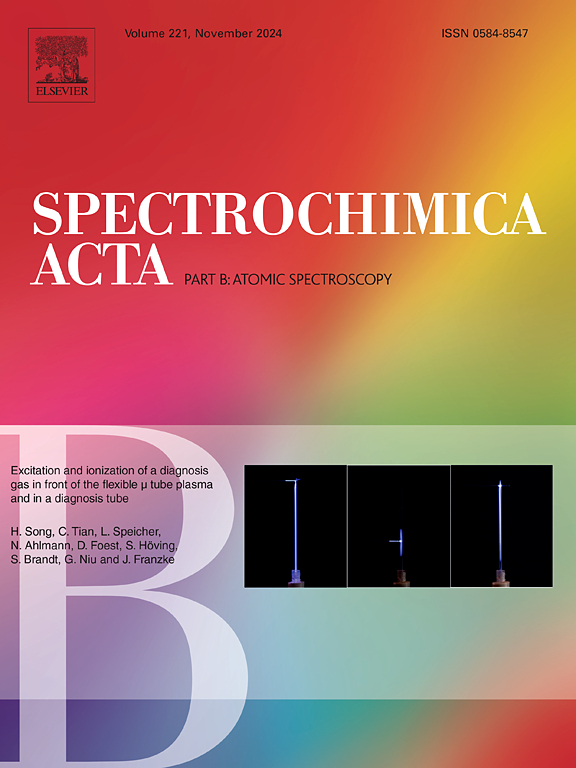Automated line identification for atomic spectroscopy (ALIAS): Application to LIBS imaging data processing
IF 3.8
2区 化学
Q1 SPECTROSCOPY
引用次数: 0
Abstract
Micro LIBS (laser-induced breakdown spectroscopy) imaging has experienced rapid growth in recent years, enabling the generation of increasingly large and complex datasets. One of the main challenges today lies in data processing, which can be extremely complex and time-consuming. In this article, we propose a new method for automatically identifying emission lines and associated elements in LIBS spectra. This work is part of LIBS imaging data processing, aimed at interpreting averaged spectra from various significant regions of the studied sample. The proposed methodology, named ALIAS (Automated Line Identification for Atomic Spectroscopy), operates by using multiple defined coefficient to find similarities between an acquired spectrum and a theoretical one derived from a simplified plasma model. The comprehensive methodology and the sequential stages of ALIAS—including peak detection, synthetic spectrum generation, intensity threshold determination, similarity coefficient computation, decision-making, and probabilistic assessment—are meticulously detailed. ALIAS's performance is then assessed across several real-world cases that present commonly encountered challenges. This study highlights the efficiency and robustness of the ALIAS method, facilitating a high degree of automation in data processing—an enduring bottleneck that continues to hinder the widespread adoption of LIBS-based imaging technology.

原子光谱线自动识别(ALIAS):在LIBS成像数据处理中的应用
近年来,微型LIBS(激光诱导击穿光谱)成像经历了快速增长,能够生成越来越大和复杂的数据集。今天的主要挑战之一是数据处理,这可能非常复杂和耗时。本文提出了一种自动识别LIBS光谱中发射谱线及相关元素的新方法。这项工作是LIBS成像数据处理的一部分,旨在解释研究样品中各个重要区域的平均光谱。该方法被命名为ALIAS(原子光谱线自动识别),通过使用多个定义系数来寻找获得的光谱与从简化等离子体模型推导的理论光谱之间的相似性。综合方法和alias的顺序阶段-包括峰检测,合成光谱生成,强度阈值确定,相似系数计算,决策和概率评估-都是精心详细的。然后,ALIAS的性能会在几个常见挑战的实际案例中进行评估。这项研究强调了ALIAS方法的效率和鲁棒性,促进了数据处理的高度自动化,这是一个持续阻碍基于libs的成像技术广泛采用的瓶颈。
本文章由计算机程序翻译,如有差异,请以英文原文为准。
求助全文
约1分钟内获得全文
求助全文
来源期刊
CiteScore
6.10
自引率
12.10%
发文量
173
审稿时长
81 days
期刊介绍:
Spectrochimica Acta Part B: Atomic Spectroscopy, is intended for the rapid publication of both original work and reviews in the following fields:
Atomic Emission (AES), Atomic Absorption (AAS) and Atomic Fluorescence (AFS) spectroscopy;
Mass Spectrometry (MS) for inorganic analysis covering Spark Source (SS-MS), Inductively Coupled Plasma (ICP-MS), Glow Discharge (GD-MS), and Secondary Ion Mass Spectrometry (SIMS).
Laser induced atomic spectroscopy for inorganic analysis, including non-linear optical laser spectroscopy, covering Laser Enhanced Ionization (LEI), Laser Induced Fluorescence (LIF), Resonance Ionization Spectroscopy (RIS) and Resonance Ionization Mass Spectrometry (RIMS); Laser Induced Breakdown Spectroscopy (LIBS); Cavity Ringdown Spectroscopy (CRDS), Laser Ablation Inductively Coupled Plasma Atomic Emission Spectroscopy (LA-ICP-AES) and Laser Ablation Inductively Coupled Plasma Mass Spectrometry (LA-ICP-MS).
X-ray spectrometry, X-ray Optics and Microanalysis, including X-ray fluorescence spectrometry (XRF) and related techniques, in particular Total-reflection X-ray Fluorescence Spectrometry (TXRF), and Synchrotron Radiation-excited Total reflection XRF (SR-TXRF).
Manuscripts dealing with (i) fundamentals, (ii) methodology development, (iii)instrumentation, and (iv) applications, can be submitted for publication.

 求助内容:
求助内容: 应助结果提醒方式:
应助结果提醒方式:


